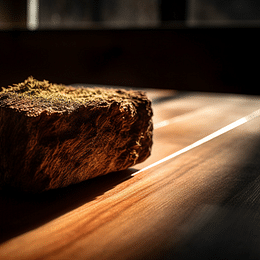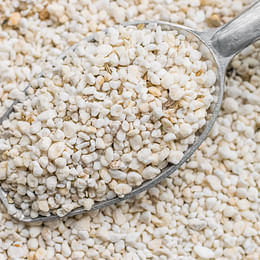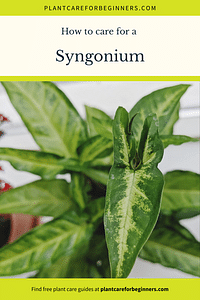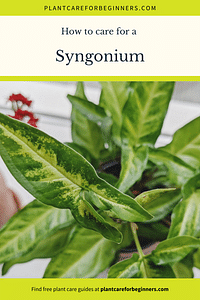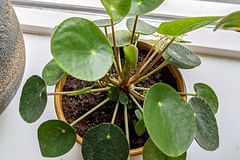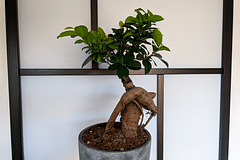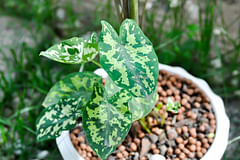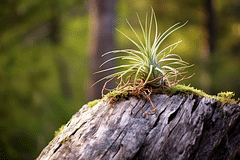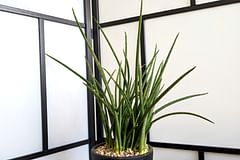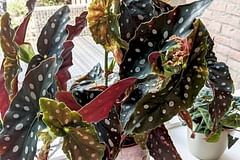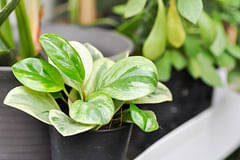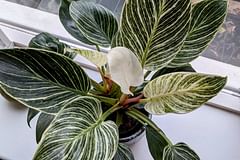How to care for a Syngonium
Syngoniums are beginner-friendly tropical houseplants for those of you who'd like to learn to take care of tropical houseplants. Syngoniums come in many shapes and sizes. In this plant care guide, we're going to discover what makes this plant happy and how we can help it thrive.
Last updated on:
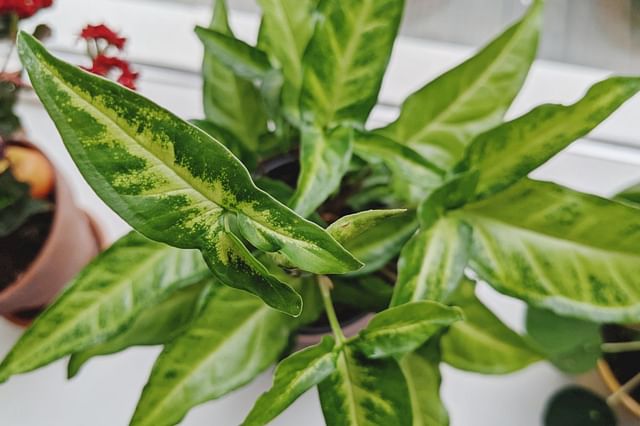
Syngonium is a family of plants that has amazing tropical plants for beginning plant owners. Syngoniums come in all shapes and sizes and have beautiful patterns on their leaves and stems. They're great plants for those of you who like to spend a little bit more time on your plants.
There are many different plants in the Syngonium family, but they all have similar plant care requirements. In this plant care guide, we're going to look at how you can take care of your Syngonium, keep it happy, and help it thrive.
These are the topics we're going to look at together:
Let's get started and learn how to help Syngonium thrive!
Watering your Syngonium
Syngoniums are tropical plants, which means they need humidity and moist soil.
Plants in the Syngonium family generally don't store a lot of moisture in their stems, so they rely on the soil to keep them hydrated.
Because these plants rely on the soil to give them plenty of moisture, you'll need to water it regularly. You shouldn't let the soil dry out completely, but you also don't want the soil to be wet for too long.
It's time to water your plant when the top inch (2.5 cm) feels dry to the touch.
On average, you should water this plant around once per week in the spring and summer. During the fall and winter, you should water them less; around every 10 days to 2 weeks.
When you're watering your plant, make sure to let any excess water drain from the pot.
If the excess water stays behind in the bottom of the pot, this could cause root rot. Root rot is very harmful to your plant and could kill it. A simple solution is to use a pot with drainage holes to let the excess water escape.
Sunlight exposure for your Syngonium
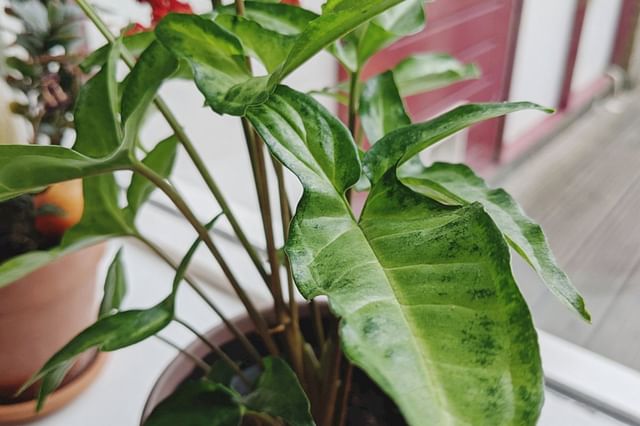
Syngoniums are tropical plants, as we've discovered. This means they're used to quite a bit of sunlight exposure in their natural environment. However, these plants are also quite small and tend to stay near the ground. Its natural living environment gives us a great clue about the kind of sunlight exposure it needs.
The perfect sunlight exposure for this wonderful type of plant is bright but indirect, sunlight.
It's important to avoid exposing this plant to direct sunlight because that will cause sunburns on its leaves. Your Syngonium will love the bright and warm spot since it's very similar to its natural environment.
When to rotate your syngonium
Syngoniums grow towards the light. If you don't want these plants to grow to one side too much, you should rotate them regularly. It's best to rotate this plant 90 degrees once per week. Each side will get the same amount of sunlight exposure and you'll help the plant to grow straight up.
If you've got these Syngoniums growing against a moss pole, I'd recommend not rotating this plant at all. When the plant is growing on a moss pole, it'll start to develop a "front side" and a "backside". By rotating the plant, you're causing the plant to grow in strange, unnatural, directions. This makes the plant look quite bad and leggy. By not rotating the plant, you get full, bushy growth.
Ideal temperature for your Syngonium
If you want your Syngonium to thrive, it's important to maintain the right temperature. These tropical plants prefer temperatures that are warm but not too hot. Ideally, the temperature should be between 60 and 85 degrees Fahrenheit (15 to 29 degrees Celsius), with an ideal daytime temperature of around 70 to 75 degrees Fahrenheit (21 to 24 degrees Celsius).
It's important to note that extreme temperature changes can stress your plant and cause it to wilt or drop its leaves. To keep your Syngonium healthy, aim for a consistent temperature and avoid placing it in areas with extreme temperature changes, such as near windows or air conditioning units.
The perfect soil for your Syngonium
Earlier, in the section about watering your Syngonium, we found out that this plant thrives when it's in moist soil. When a plant loves to be in moist soil, we need to think about the type of soil to use for our plant.
Moist soil should retain moisture for a longer period and not compact over time. The soil should retain moisture for at least 6 days without drying out. It's also important that the soil doesn't compact over time.
When the soil compacts over time, it's difficult for oxygen to reach your Syngonium's roots. When oxygen can't reach the roots, it's easy for root rot to happen.
A great mixture should contain 1/2 general potting soil, 1/4 peat moss, and 1/4 perlite. This mixture will hold onto moisture well while also draining the excess moisture to the bottom of the pot. The peat moss and perlite give the soil a bit of "structure". This structure prevents the soil from compacting too quickly over time as your plants grow in moist soil.
If you want to find out more about making your soil retain more moisture, have a look at How to make your soil retain more water?.
Fertilizing your Syngonium
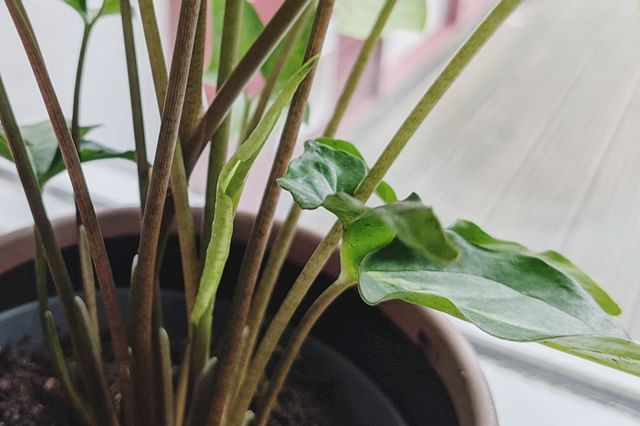
Your Syngonium relies on the soil to provide it with moisture and nutrients to grow. Syngonium is also a fast-growing houseplant, which means it absorbs nutrients in the soil quickly. It then uses these nutrients to maintain its fast growth and stay healthy.
You can help your Syngonium stay healthy during the growing period (spring and summer) by fertilizing it occasionally. During the growing period, you should fertilize the Syngonium every two weeks.
You shouldn't fertilize it during the fall and winter because it will be in its dormancy period.
When your Syngonium is in its dormancy period, it uses a lot less energy to grow, so the fertilizer will stay behind in the pot and won't be absorbed. Over time, this will make the soil acidic and this can be harmful to your plant.
The best fertilizer for these types of plants is a liquid fertilizer. Liquid fertilizer is great for plants that use a lot of nutrients to grow and need to absorb them quickly.
Propagating your Syngonium
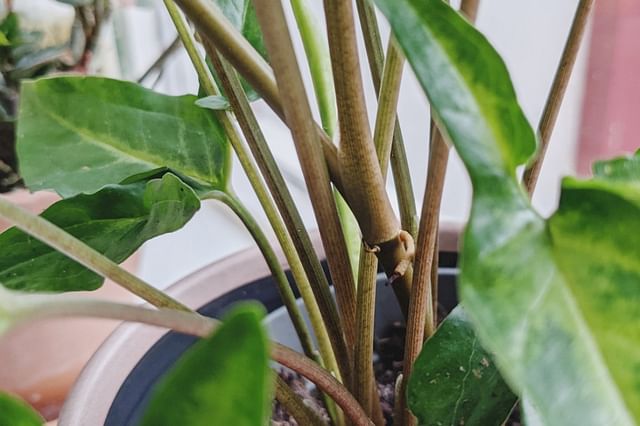
When you've taken great care of your Syngonium and it has grown quite a bit, you might start to notice nodes on your plant. You can see one of these nodes in the photo above: a thicker part in the stem that starts to grow roots.
You can propagate these stems with nodes by cutting off the stem about an inch (2.5 cm) under the node and putting the cutting in a jar with clean water. The cutting will now slowly start to grow roots. When the roots are about 2 inches (5 cm), you can plant it in soil and you'll have successfully propagated your Syngonium.
Pruning your Syngonium
Pruning your Syngonium plant is important for its growth and health. However, it can be a little scary for beginning plant owners. Pruning isn't as complicated as you may think. Follow these easy steps, and you can keep your Syngonium happy and healthy in the long term.
Before you can prune your Syngonium, look for any dead or dying stems and leaves. They will look like yellowing leaves or sometimes even crispy brown leaves. These are the parts you'll want to prune.
Use a pair of sharp, clean pruning shears to prune these stems and leaves. Make sure to cut only the stem or leaf, avoiding any damage to the healthy parts of the plant. Cut the stem or leaf close to the nodes, because this will encourage new growth.
Remember to sanitize your pruning shears before and after use to prevent the spread of any plant diseases. You can dip a cotton swab in rubbing alcohol and use it to clean the shears. You can also use hot water and soap to clean the shears.
If your plant is starting to grow too tall, you can cut the stems off and propagate these cuttings as we've discovered in the previous section. This will give you new Syngoniums for free!
After pruning your plant, wait with watering it for a day or 2. The wounds need to dry up and form a callus. If you were to water it right away, the wounds don't get a chance to heal. After the callus has formed, water your plant and add some liquid fertilizer to help the plant recover.
Repotting your Syngonium
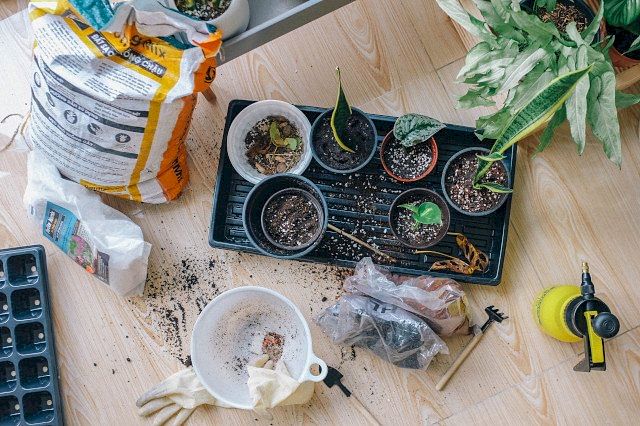
Keeping a close eye on your Syngonium can help it start and stay strong. Check out the growth patterns, soil, and pot size as all this information gives you a clue about when you should repot your plant.
Repotting your plant is a great idea as it gives them plenty of room to grow and fresh soil to use for nutrients. You'll reward yourself in the end when you see the improved growth rate and healthy vibes that come from giving the Syngonium some more leg and root freedom.
Signs your Syngonium should be repotted
Syngoniums should be repotted every 1-2 years, or when you notice that the roots have outgrown the pot. If you notice that your Syngonium is outgrowing its current pot or the roots are becoming tangled, it might be time to repot it.
Another sign to look out for is if the soil is drying out much faster than usual, which could mean that the plant is struggling to find enough space for its roots to grow. If you notice that the plant is wilting or not growing as well as it used to, this may also be a sign that it needs a larger pot with fresh soil.
How to repot a Syngonium
When repotting your Syngonium, make sure to use a well-draining, nutrient-rich soil mix that is made for tropical plants. It's also important to choose a pot that is slightly larger than the current one, but not too big as this could overwater the plant.
A pot that's too big will hold a lot of extra soil. This soil will hold onto moisture, but the plant can't absorb it all as quickly as it could in its old pot, so the soil stays moist/wet for too long. This could overwater your plant and cause root rot.
When you're ready to repot, gently remove the plant from its current container and loosen any tightly bound roots. Place the plant in the new pot and fill in the space around it with the fresh potting mix. Water the plant thoroughly after repotting it and place it back in its preferred location.
Preventing pests and diseases

Preventing pests and diseases in your Syngonium plant is essential for maintaining its health and ensuring successful growth. Here are some tips to keep them at bay:
Regularly inspect your Syngonium
Make sure to regularly check your plant for any signs of insect infestations or disease. Look for yellowing or withering leaves, webbing, or visible bugs. If you notice any of these signs, use a neem oil mixture or chemical pesticides (if the infestation is very large) to remove the pests.
Keep your plant clean
Dust and debris can attract insects and disease-causing bacteria. Be sure to wipe down the leaves with a damp cloth often, and keep the soil free of any debris or fallen leaves.
Besides preventing pests and diseases, this also makes your plant look better and helps to, temporarily, increase the humidity around your plant.
Proper watering
Syngonium plants prefer moist but well-draining soil. Overwatering can cause root rot and attract pests. Water your plant only when the soil is dry to the touch.
Humidity
Syngonium plants thrive in high-humidity environments. You can increase humidity by misting the leaves or using a humidifier. The higher humidity also helps to prevent a majority of the common houseplant pests, as they thrive when the plant is dry.
Don't confuse a higher humidity with watering your plant more often, as wet soil is a magnet for pests.
Natural remedies
When you've got an infestation of pests on your plants, you should get rid of it using a neem oil mixture or a chemical solution. But the best way to deal with pests is to be quicker than them: prevent them from getting to your plant.
By regularly spraying your plant with a neem oil solution and wiping the plant down, you're actively helping to prevent pests from getting to your plant. This is the best way to deal with pests.
Toxicity for pets
Like many other tropical plants, plants in the Syngonium family are toxic for your pets.
If you have pets or small children, it's best to keep these plants out of reach. If you have pets that like to chew on your plants, make sure to keep an eye out.
The sap in the stems and leaves could cause indigestion and irritation when consumed. Make sure to contact your veterinarian if you notice your pet has chewed on your Syngonium.
Troubleshooting common problems
If you're experiencing issues with your Syngonium, don't worry! Here are some common problems and solutions to get your plant thriving again.
Yellowing leaves
This can be a sign of overwatering, underwatering, or too much direct sunlight. Check the soil moisture level and adjust your watering frequency. If the plant is receiving too much sunlight, move it to a less bright spot.
Wilting or drooping leaves
This usually means that the plant is thirsty and needs to be watered. If the soil is dry to the touch, give it a good drink of water and it should perk up in a few hours.
Brown tips on leaves
This could be a result of low humidity or salt build-up in the soil. Increase the humidity around the plant by misting it regularly and consider using distilled water for watering to avoid salt build-up.
Pests
Common pests that affect Syngonium include spider mites, mealybugs, and scale insects. Check the plant regularly for any signs of infestation and fix the issue quickly with an appropriate insecticide.
Growing your Syngonium outdoors
Syngoniums are flexible and can be grown both indoors and outdoors. Many gardeners find that their Syngoniums thrive better outside because there is much more natural light and fresh air.
When growing Syngoniums outdoors, it's important to make sure they are planted in well-draining soil and are protected from strong winds. They also benefit from regular fertilization to help encourage healthy growth and development.
One key thing to keep in mind is that Syngoniums are native to tropical regions, so they prefer warm and humid conditions. If you live in a colder climate, you may need to bring your Syngonium inside during the winter months or provide additional protection to keep them healthy and happy.
Train your Syngonium to climb a support

Syngoniums are natural climbers and can easily be trained to climb a trellis or a moss pole. Here are some steps to help you train your Syngonium to climb.
Start by choosing the right support. The support should be sturdy and tall enough to help your Syngonium as it grows. A trellis or stake made of bamboo or wood can work well.
Move the support close to the base of the plant so that the stems and air roots of Syngonium can easily grab onto it. In the beginning, you might need to use soft garden ties, such as twine or plant ties, to gently tie the stems of your Syngonium to the support. Be careful not to tie them too tightly, as this can damage the plant.
As your Syngonium grows, continue to tie the stems to the support. You may need to adjust the ties and make sure the stems are evenly distributed along the support. Eventually, the plant should be able to grow against the support by itself, but by keeping it close to the support, you're training it.
If your Syngonium becomes too large or unruly, you can prune it back to keep it under control. However, be careful not to prune too much, as this can stunt its growth.
It's important to remember that training your Syngonium to climb may take some time and patience.
Conclusion
If you love tropical houseplants that are easy to take care of, a plant in the Syngonium family is perfect for you. It's an easy plant to take care of and it doesn't need a lot of special care. You can help this plant be happy by keeping it in a bright spot and keeping its soil moist.
Every two weeks, during the spring and summer, you should fertilize it to help it grow big and strong. It's a great plant for beginning plant owners that want to learn how to take care of tropical houseplants, as Syngoniums are quite forgiving and recover quickly.
Thank you for reading this post! I hope it helps you to keep your plants healthy and beautiful! If you're looking for more guides on specific plants, you can always request a plant guide to get a guide for the plant you have trouble with.
Tags: beginner-friendly, Plant care tips, fast-growing, tropical
Posted on: May 29, 2021 Last updated on: Jun 1, 2023